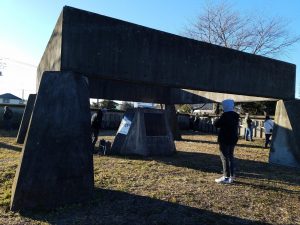
Insult is given in commemoration of the environmental havoc wrecked by the Ashio Copper mine’s water pollution.
Incense lies half burned beneath the concrete altar. The vases are sealed by spider webs and filled with black water. A dry lichen grows along the face of the supporting columns. The lichen crumbles off in a puff of green dust as I run my hand across the pillar.
This is what the “Kyū Yanaka-mura gōdō irei-hi,” Yanaka Village Memorial Site, looks like (my translation). Construction of this memorial by the Ministry of Construction can only be a deliberate offense to the Yanaka villagers as the back face of the tombstone, which lists the first names associated with the tombstone are sealed up against the concrete wall surrounding the memorial. The wall hides the specific victims of the Ashio Copper Mine. The dilapidated state of the shrine indicates the governments success in constructing a memorial which does not encourage remembrance of the villager’s descendants. Water pollution of the Watarase Basin from copper mining is conveniently forgotten along with the villagers.
This memorial stands in stark contrast to the presentation of my family shrine in Hiroshima, Japan. My family’s gravestone is tucked in a shaded alcove, made of polished granite with carved black lettering. The gravestone sits on two large rocks stacked on top of each other. The grave rests on a high hill with a view overlooking Hiroshima. This presentation is worthy of the honor one’s ancestors deserve. This grave is only for one family. The Yanaka Village Memorial Site should be far more grandiose as it contains the gravestone of most families who lived in Yanaka Village. My relatives in Japan clean our shrine annually washing the gravestone, placing fresh flowers in the vases, and burning incense before the gravestone to purify the space. I’ve washed my family’s shrine, in Hiroshima Prefecture and feel somewhat able to properly show respect to the people of the memorial. I turn hopefully to my professors and Japanese guides, wishing to see them approach the altar with incense or buckets of water. Visitation to this memorial was unexpected so neither is available. Ironically, my first response is to rely on my superiors for help. I am repeating the pattern of dependence that stymied village protesters from directly confronting Furukawa Corporation, the owners of this mine, and instead hoping for government aid.
I take photos of the eerie memorial, whose suffering is left vulnerably on display. I have taken instead of giving back to this exploited community.
In writing this story, I hope to spread the memory of the Yanaka Villagers and the environmental destruction caused by the Ashio copper mine. Passing on this memory hopefully conveys the respect to Yanaka I wanted to give with flowers and water.
Recent Comments